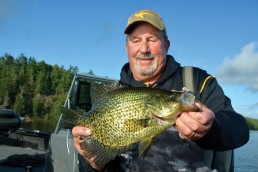Chasing Giant Crappies All Season Long
SHARE THIS POST
Walleyes, bass and muskies get the attention of most fishermen, but Tom Neustrom’s passion is for big crappies.
Understanding these gems has taken multiple decades of applying patience and insight. Sure, in the spring of the year, no matter the geographical location, early-season crappies are fairly predictable. Where good populations of crappies exist, shallow spawning locations are prime spots to catch numbers of fish. Many anglers give up on crappies after the pre-spawn and spawning rituals, and then pursue other species. Crappies, especially the monsters that one envisions, disperse and become nomadic at best. In many southern impoundments after the spawn that occurs in March and April, crappies will inhabit shoreline brush piles, submerged timber and gravel points. Up north, it seems to be a different story.
As crappies disperse from their spawning locations, newly emerging weed beds are prime locales. Another favorite of mine is to find trees that have blown down into the water over the passing of time. They attract bugs and small minnows that are right up a crappie’s alley.
Whether weed lines or downed trees, these fish are very vulnerable to slip bobber approach or a small tube jig cast and retrieved right in the target zone.
As they roam mid-depth locations in search of food, small baits like Rapala Ultra Shad Raps can be great search lures. Cast or slowly trolled, Ultra Shads can find crappies fast. Once located, I will save the location on my Humminbird electronics and then go back and pitch small jigs, fancasting the area before I move on. Many times, I use my Humminbird Helix 12 with Side Imaging, searching for shallow cover such as brush, logs, rocks and anything that may hold additional fish. Visual searching of newly emerging reed beds also reveals hard spots and possibly newly forming cabbage beds that are key locations moving into summer.
As the heat of the summer begins to warm the surface temperatures crappies live extensive parts of their lives on weed lines, roaming cabbage and pockets in search of food sources. Small minnows from the spring hatch and new bug hatches make up most of their diet, and this continues throughout the summer months.
True crappie hunters move from spot to spot and scour likely hangouts. Searching for giants is specific to all species of fish, and schools of monsters is not the case, for the most part, when fishing for crappies. In summer locations, large crappies are individuals that may have companions of size, but they will also move in schools with multiple sizes of fish. Many times, the larger crappies will tend to be on the perimeter or just below the average or smaller crappies. Locations and size ranges can change dramatically as the water begins to cool in late summer.
Are you enjoying this post?
You can be among the first to get the latest info on where to go, what to use and how to use it!
A pattern that has been particularly successful for locating big crappies in summer and late-summer is slow-trolling spinners over and through weeds that contain numbers of fish. The pace can be anywhere from 1.2 to 1.5 mph, depending on the depth of the weed bed. My favorite spinner setup is a #3 Colorado blade with a #1 VMC Gold long-shanked hook. I prefer a 2-inch chub or shiner minnow, and many times when the fish are really active, I will attach a 2- to 3-inch action tail instead of a minnow.
The bite can be fierce at times, so I prefer a 7-foot to 7-foot, 6-inch light-action rod teamed with a Daiwa 1000 Tatula LT spinning reel. This combo gives me plenty of power to muscle big crappies out of heavy cabbage, but also allows the fish to momentarily not feel the rod when they strike. The leader is approximately 36 inches in length, with a 3/16- to 1/8-ounce bullet sinker attached above the leader to slip and slide through the heaviest cover. If I am fortunate to contact a pocket of monster crappies, I will drop my Talon Anchoring System and cast small baits like the Ultra Lite Shad Rap or small jigs with action tails over the top of the weeds.
The spinner presentation is a great search system when covering large cabbage flats or isolated cover patterns that require long trolling passes. I use my Humminbird Helix 12 to create trails to maintain the proper trolling passes so I can continuously repeat the successful ones. I may alternate the pass slightly each time to make sure I didn’t spook fish on the previous one. This is a deadly late-summer pattern when crappies are in the cabbage or other weeds they inhabit.
Big crappies, I mean the ones that dreams are made of, have been a passion of mine for decades. Time on the water and investigating all locations over the years have made me a better all-around angler for many species. Unlocking the door on monster crappies has etched an everlasting memory for me.
Learn more crappie fishing tips from MidWest Outdoors magazine, by subscribing on our website.
MWO
SHARE THIS POST
You may also like...
Nothing found.
Did you enjoy this post?
You can be among the first to get the latest info on where to go, what to use and how to use it!
